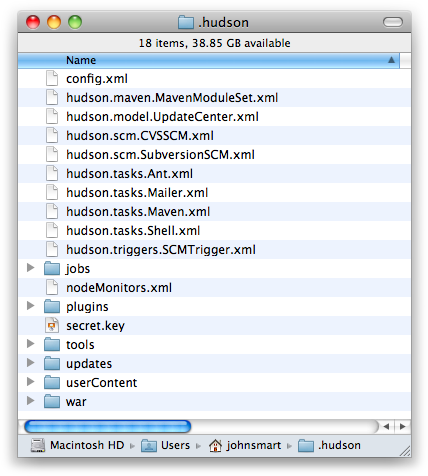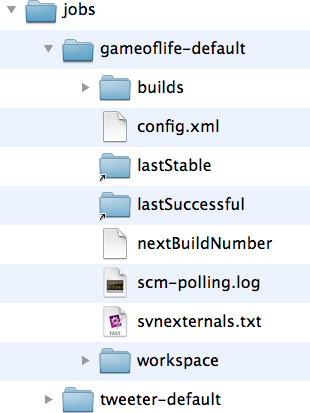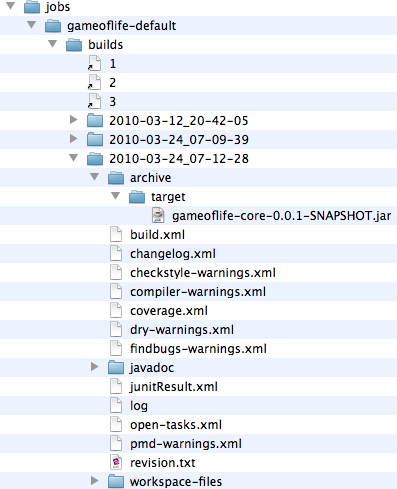The Jenkins home directory contains all the details of your
Jenkins server configuration, details that you configure
in the Manage
Jenkins screen. These configuration details are stored in the form of
a
set of XML files. Much of the core
configuration, for example, is stored
in the
config.xml
file. Other
tools-specific configuration is stored in other appropriately-named XML
files: the details of your Maven
installations, for example, are stored in
a file called
hudson.tasks.Maven.xml
.
You rarely need to modify these files by hand, though occasionally it
can
come in handy.
The Jenkins home directory also contains a number of subdirectories (see Figure 3.7, “The Jenkins home directory” ). Not all of the files and directories will be present after a fresh installation, as some are created when required by Jenkins. And if you look at an existing Jenkins installation, you will see additional XML files relating to Jenkins configuration and plugins.
The main directories are described in more detail in Table 3.1, “The Jenkins home directory structure” .
Table 3.1. The Jenkins home directory structure
The jobs directory is a crucial part of the Jenkins directory structure, and deserves a bit more attention. You can see an example of a real Jenkins jobs directory in Figure 3.8, “The Jenkins jobs directory” .
This directory contains a subdirectory for each Jenkins build job
being managed by this instance of Jenkins. Each job
directory in turn
contains two
subdirectories:
builds
and
workspace
, along with some other
files. In particular, it contains the build job
config.xml
file, which
contains, as you might expect, the configuration details for this build
job. There are also some other
files used internally by Jenkins, that you
usually wouldn’t touch, such as the
nextBuildNumber
file (which contains the number
that will be assigned to the next build in this build job), as well as
symbolic links
to the most recent successful build and the last
stable
one. A successful build is one that does not have any
compilation errors.
A stable build is a successful build that has passed whatever quality
criteria you may have
configured, such as unit tests, code coverage
and so
forth.
Both the
build
and the
workspace
directories are important.
The
workspace
directory is where
Jenkins builds your project: it contains the source code Jenkins checks
out, plus any files
generated by the build itself. This workspace is
reused for each successive build—there is only ever one
workspace
directory per project, and the disk
space it requires tends to be relatively stable.
The
builds
directory contains a
history of the builds executed for this job. You rarely need to intervene
directly in these
directories, but it can be useful to know what they
contain. You can see a real example of the builds directory in
Figure 3.9, “The builds directory”
, where three builds have
been performed. Jenkins stores
build history and artifacts for each build it performs in a
directory labeled with a timestamp (“2010-03-12_20-42-05”
and so forth in
Figure 3.9, “The builds directory”
). It also contains
symbolic links with the actual build numbers that point to the build
history directories.
Each build directory contains information such as the build result log file, the Subversion revision number used for this build (if you are using Subversion), the changes that triggered this build, and any other data or metrics that you have asked Jenkins to keep track of. For example, if your build job keeps track of unit test results or test coverage metrics, this data will be stored here for each build. The build directory also contains any artifacts you are storing—binary artifacts, but also other generated files such as javadoc or code coverage metrics. Some types of build jobs, such as the Jenkins Maven build jobs, will also archive binary artifacts by default.
The
size of the
build
directory will
naturally grow over time, as the build history cumulates. You will
probably want to take this into
account when designing your build server
directory structure, especially if your build server is running in a
Unix-style environment with multiple disk partitions. A lot of this
data
takes the form of text or XML files, which
does not consume a large amount
of extra space for each build. However, if your build archives some
of
your build
artifacts, such as JAR or WAR files, they too will be stored
here. The size of these artifacts should be factored into
your disk
space
requirements. We will see later on how to limit the number of builds
stored for a particular build job
if space is an issue. Limiting the
number of build jobs that Jenkins stores is always a trade-off between
disk space
and keeping useful build statistics, as Jenkins does rely on
this build history for its powerful reporting features.
Jenkins uses the files in this directory extensively to display build history and metrics data, so you should be particularly careful not to delete any of the build history directories without knowing exactly what you are doing.


